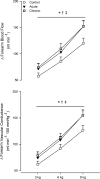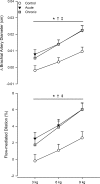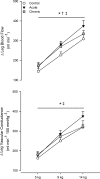Folic acid ingestion improves skeletal muscle blood flow during graded handgrip and plantar flexion exercise in aged humans
- PMID: 28667051
- PMCID: PMC5625172
- DOI: 10.1152/ajpheart.00234.2017
Folic acid ingestion improves skeletal muscle blood flow during graded handgrip and plantar flexion exercise in aged humans
Abstract
Skeletal muscle blood flow is attenuated in aged humans performing dynamic exercise, which is due, in part, to impaired local vasodilatory mechanisms. Recent evidence suggests that folic acid improves cutaneous vasodilation during localized and whole body heating through nitric oxide-dependent mechanisms. However, it is unclear whether folic acid improves vasodilation in other vascular beds during conditions of increased metabolism (i.e., exercise). The purpose of this study was to test the hypothesis that folic acid ingestion improves skeletal muscle blood flow in aged adults performing graded handgrip and plantar flexion exercise via increased vascular conductance. Nine healthy, aged adults (two men and seven women; age: 68 ± 5 yr) performed graded handgrip and plantar flexion exercise before (control), 2 h after (acute, 5 mg), and after 6 wk (chronic, 5 mg/day) folic acid ingestion. Forearm (brachial artery) and leg (superficial femoral artery) blood velocity and diameter were measured via Duplex ultrasonography and used to calculate blood flow. Acute and chronic folic acid ingestion increased serum folate (both P < 0.05 vs. control). During handgrip exercise, acute and chronic folic acid ingestion increased forearm blood flow (both conditions P < 0.05 vs. control) and vascular conductance (both P < 0.05 vs. control). During plantar flexion exercise, acute and chronic folic acid ingestion increased leg blood flow (both P < 0.05 vs. control), but only acute folic acid ingestion increased vascular conductance (P < 0.05 vs. control). Taken together, folic acid ingestion increases blood flow to active skeletal muscle primarily via improved local vasodilation in aged adults.NEW & NOTEWORTHY Our findings demonstrate that folic acid ingestion improves blood flow via enhanced vascular conductance in the exercising skeletal muscle of aged humans. These findings provide evidence for the therapeutic use of folic acid to improve skeletal muscle blood flow, and perhaps exercise and functional capacity, in human primary aging.Listen to this article's corresponding podcast at http://ajpheart.podbean.com/e/folic-acid-and-exercise-hyperemia-in-aging/.
Keywords: aging; exercise hyperemia; vascular conductance.
Copyright © 2017 the American Physiological Society.
Figures




References
Publication types
MeSH terms
Substances
Grants and funding
LinkOut - more resources
Full Text Sources
Other Literature Sources
Medical

